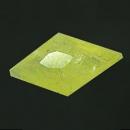|
|
||||||||||||||||
|
||||||||||||||||
|
||||||
|
|
|
|
Cancrinite
|
|
| | |
| Discovered in 1839; IMA status: Valid (pre-IMA; Grandfathered) | ||
|
| ||
|
Chemistry |
|
|
| |
|
Na6Ca2Al6Si6O24(CO3)2 | |
|
|
Sodium Calcium Aluminum Silicate Carbonate |
|
Molecular Weight: |
1,052.50 gm |
|
Composition: |
Sodium |
13.11 % |
Na |
17.67 % |
Na2O |
|
|
Calcium |
7.62 % |
Ca |
10.66 % |
CaO |
|
|
Aluminum |
15.38 % |
Al |
29.06 % |
Al2O3 |
|
|
Silicon |
16.01 % |
Si |
34.25 % |
SiO2 |
|
|
Carbon |
2.28 % |
C |
8.36 % |
CO2 |
|
|
Oxygen |
45.60 % |
O |
|
|
|
|
|
100.00 % |
|
100.00 % |
= TOTAL OXIDE |
|
|
|
||||
|
Classification |
|
|
| |
|
Silicates (Germanates) | |
|
8/J.09-10 | |
|
|
9 : SILICATES (Germanates)
|
|
Related to: |
Cancrinite Group. |
|
Members of Group: |
Cancrinite Group: Afghanite, Alloriite, Biachellaite, Bystrite, Cancrinite, Cancrisilite, Davyne, Depmeierite, Franzinite, Giusseppeite, Hydroxylcancrinite, Kircherite, Kyanoxilite, Liottite, Marinellite, Microsommite, Pitiglianoite, Quadridavyne, Sacrofanite, Tounkite, Vishnevite |
|
Varieties: |
None |
|
Synonyms: |
None |
|
|
|
|
Crystal Data |
|
|
|
|
|
Rarely as prismatic crystals, terminated by a low pyramid, to 2 cm; commonly massive. |
|
|
Lamellar, rare |
|
|
|
|
|
Physical Properties |
|
|
|
|
|
Perfect on {1010}, Poor on {0001} |
|
|
Irregular/Uneven |
|
|
Brittle |
|
|
5.0 - 6.0 |
|
|
2.42 - 2.51 (g/cm3) |
|
|
None |
|
|
Not Radioactive |
|
|
|
|
|
Optical Properties |
|
|
|
|
|
Colorless, White, light Blue to light Grayish Blue, honey-Yellow, Orange, Reddish; Colorless in thin section |
|
|
Transparent to Translucent |
|
|
Vitreous, Pearly or Greasy |
|
|
1.495 - 1.528 Uniaxial ( - ) or ( + ) |
|
|
0.012 - 0.025 |
|
|
Weak |
|
|
Colorless |
|
|
|
|
|
Occurances |
|
|
|
|
|
Geological Setting: |
A primary mineral in some alkalic igneous rocks, including pegmatites in nepheline syenites; also as an alteration product of nepheline. |
|
Common Associations: |
Nepheline, Sodalite, Natrolite, Orthoclase, Monticellite, Litanian Andradite, Zircon |
|
Common Impurities: |
Ti, Fe, Mg, K, Cl, S |
|
Type Locality: |
Miass (Miask), Ilmen Mts, Chelyabinsk Oblast', Urals Region, Russia |
|
Year Discovered: |
1839 |
|
View mineral photos: | |
|
|
|
|
More Information |
|
|
|
|
|
| |
|
|
|
|
Current sources
of Cancrinite are Bancroft, Ontario, Canada; Eifel Mountains,
Germany; Kola Peninsula, Russia; AlnŲ, Sweden
and Litchfield,
Maine, USA. |
|
|
We
have not photographed the Cancrinite gems
yet. Please
check back soon. |
